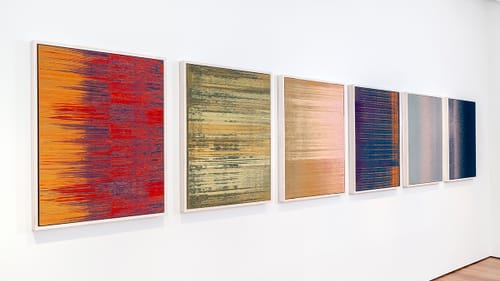Stay in the Loop
BSR publishes on a weekly schedule, with an email newsletter every Wednesday and Thursday morning. There’s no paywall, and subscribing is always free.
Secondary sounds
Fabric Workshop and Museum presents Sonic Presence (or Absence): Sound in Contemporary Art

Sonic Presence (or Absence): Sound in Contemporary Art, the latest exhibition at Fabric Workshop and Museum (FWM), has more problems than a bad title (lack of specificity; too much punctuation). Curator Alec Unkovic turns sound into a largely perfunctory and joyless affair. There is only one piece of interesting music in the whole show, with the other sound pieces being D-grade ambient music or, in one case, a person simply talking.
The strongest element of the curation is what I call pose-able art: almost-immersive pieces inviting visitors to stand in front of them and take pictures. Every museum is duty-bound to host at least one of these, and this FWM show boasts three.
Interesting visuals
Yinka Shonibare’s Space Walk features life-size upholstered astronauts floating midair (perfect to crouch beneath for a selfie or group photos). The tenuous connection to sound is the use of album-cover art as inspiration for the patterns that cover the astronauts. Meanwhile, Glenn Ligon’s Skin Tight is even more of a stretch: a collection of cylindrical punching bags in a nice red setting. The supposed connection to sound here is hip-hop. Peter Edwards’s Specter comprises large spheres that change color in response to pitch and volume.
The best visual pieces on display here capture the mathematical and intensive ritual elements of sound, utilizing elegant ekphrastic processes.
The one with the heaviest symbolic and emotive power, and probably the show’s best piece, is Nick Cave’s Soundsuit. Standing more than seven feet tall, this towering outfit looks like Charlemagne Palestine’s stuffed-animal chic meets the Kukeri of Bulgaria. I would love to see a performance of dancers outfitted in these.
Mika Tajima’s Negative Entropy series consists of multicolor cotton fabric, which reveals the mathematical relationships of the pitches composing room timbre at Philadelphia industrial and technological sites. The luminescent fabric highlights different pitch relationships depending on where you look at it, much like sound transforms from the point of origination to the point of reception.

Terry Adkins’s Aviarum physicalized the variations in amplitude inside bird calls with metal discs showing the loudness patterns of a mourning dove and a broad-shouldered hawk.
The truth about plant music
Unfortunately, the largest category of works on display are twee conceptual pieces that are visually drab and acoustically unexciting. This is best exemplified by Raúl Romero’s Music for Plants, which is so far deep into cliché that it cannot be recovered.
Despite countless TikTok-ers trying to make it seem magical, “plant music” is generally just using the conductivity of plants and the random electrical signals of the environment to control preset parameters. Romero’s work falls into this category. In absolutely no fundamental way is this about the plant making music, or any type of floral intelligence; it's still about the composer. Generally, if the composer is great at music, then so is the plant. Unfortunately, it's boring, drone-heavy ambient music across the provided LP. Every single piece might as well be the same.
Please, have a seat
The only piece with sonic potential in the room is Guillermo Galindo’s Sonic Border. Three of his works are displayed on pedestals with speakers built into them. Each has synced musical tracks playing, solo or duo or trio, on a four-hour loop. These home-built instruments have delightfully strange and synthetic timbres. The compositions are random and repetitive, but they play well in the boom-y loft space.
However, it is simply not possible to hear these pieces for a prolonged, uninterrupted period, as there is no seating in the area, and no headphone option. This forces listeners to stand if they wish to catch more of the soundtrack.
Seating exists for other musical works in the show, but it was highly uncomfortable. Why are we still treating tiny stools with no support as adequate seating? Does FWM just want to shuffle people in and out? If the idea is for people to listen for 30 seconds and then move on, then why does the installation provide a whole side of an LP of material or almost four hours, in the case of Sonic Borders? The experience of these pieces seems abortive by design, but then again, most of the pieces have so little to say.
For several of the pieces, headphones are provided, but there is no volume control on the headphones. Why would the installers make it impossible to adjust the volume on a private listening experience?
Ultimately, this exhibition treats sound as a pretense to display visual work, not as a focal point. As a space to beat the heat when walking around Center City, or as an opportunity to pose in front of "big art" for Instagram and TikTok, it’s worth stopping in (admission is free). In all other aspects, it’s a morass which refuses sustained attention.
What, When, Where
Sonic Presence (or Absence): Sound in Contemporary Art. Through January 7, 2024, at Fabric Workshop and Museum, 1214 Arch Street, Philadelphia. Free. (215) 561-8888 or fabricworkshopandmuseum.org.
Accessibility
FWM is accessible for standard-size wheelchairs. Visit the museum’s access services page for more info and other accessibility needs.
Sign up for our newsletter
All of the week's new articles, all in one place. Sign up for the free weekly BSR newsletters, and don't miss a conversation.

 Aaron Pond
Aaron Pond